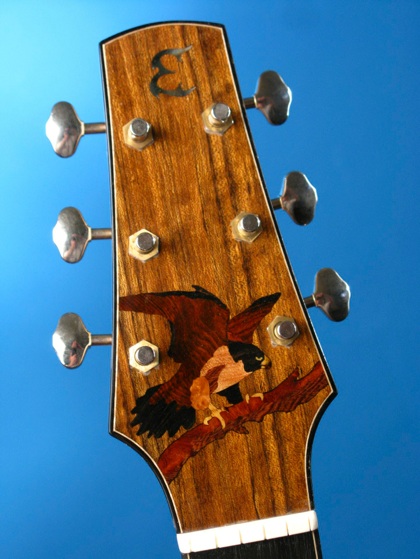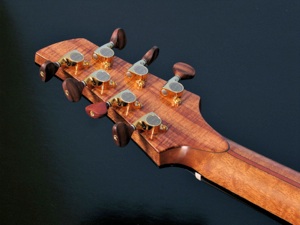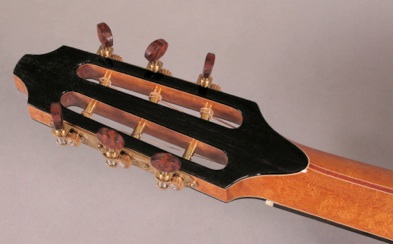Design Philosophy 5

The Headstock
Friday, August 9, 2013
Two important factors that I take into consideration when designing a headstock are: 1. The vertical break angle of the strings from the nut to the tuner posts; and 2. The horizontal break angle of the string from the nut to the tuner posts.
The difference is simple. The vertical break angle must be sufficient to exert the right amount of down-pressure on the nut to prevent rattles and buzzes at the nut, specifically in the string slots. The horizontal break angle is the degree to which a given string angles outward, or splays, from the nut to the tuner post.
With a solid headstock, a good angle for the headstock is about thirteen degrees. When a headstock tilts downward from the nut, that angle works well to provide sufficient down pressure of the strings on the nut.
With a slotted headstock, an eight-degree headstock tilt is sufficient, because the tuner posts go through the center of the headstock, making the string angle steeper than the headstock angle. In either case, the essential factor is snug, well-seated, slop-free contact between the nut and the strings. This will eliminate the problem of extraneous string noises at the nut, messing up the tone.
Most steel string headstocks are a solid, so-called “paddle” style, which tapers wider toward the top, or crest of the headstock. Martins, Gibsons, and the majority of other production guitars have this style of headstock, with a huge number of variations on the shape. Some of them are spare and elegant, as with Martin headstocks, while others can be extravagantly flared and embellished, as often seen on archtop guitars.
This design causes the strings to splay off the nut at an angle; sometimes a fairly steep angle. Not that this is a bad thing. If the guitar is well set up, and the string slots in the nut are accurately cut, there should be no problem with tuning.

I build two basic styles of headstock. My solid headstock has a few variations, depending on the size of the guitar. All of them taper narrower toward the crest. I call this style the “Delta” headstock. Some other luthiers call this the “snakehead” style.
I make the Delta style in both symmetric and asymmetric versions; the asymmetric Delta is always used on multiscale (fanned-fret) guitars, and can also be used to stylish effect on single-scale instruments.
I also offer a unique slotted headstock which I call the “Pogoda” style. The crest of this headstock is reminiscent of the roof lines of an Asian temple, hence the name. The photo at the top of the page is a Pogoda style slotted headstock. As you can see, the Pogoda also tapers narrower toward the crest, so the string pull over the nut will be a straighter line.
The Pogoda slotted headstock takes about twice as much time to make as a solid Delta headstock, but I really enjoy the process. I have gotten some rave reviews for the Pogoda from several clients and aficionados too. I’m proud of this design.
As an artisan’s prerogative I choose to embellish every headstock with bindings and purflings, usually matching the theme and the woods to those on the fingerboard, for a cohesive design. I don’t charge extra for a bound headstock. I like the way they look, so I do them all this way.
Also, I include front and back headstock plates on every guitar, both for style points and structural integrity. The headstock plates are either one-piece, exotic figure wood, or a bookmatched set to echo the other woods used on the guitar. Edwinson headstocks are built very strong. It would take a catastrophic impact to break one.
...and, about the tuning machines...
Life is too short to waste time messing around with crappy tuning machines. This is no place to cut corners. I only use premium tuners on all my guitars. Fortunately there is a vast array of great choices. My favorite brands are Gotoh, Grover, Schaller, Schertler, and Waverly. All of these come in a nice selection of styles and finishes, from moderate to expensive, all featuring good to excellent quality machining, fit and finish.
You can spend anywhere from around $60 to $500 for a primo, off-the-shelf set. There are also some custom, handmade tuners available that can run from $500 to $1000 or more per set. Please inquire, if you are interested in having the best of the best tuners on your custom Edwinson.
Otherwise, here are a couple links to show you some popular choices: Luthier’s Mercantile and Stewart McDonald
Below, a jumble of photos of various headstocks I’ve built over the years...
A guitar’s headstock is often the most recognizable style point on the instrument. The shape and profile usually signify the identity of the maker, and the headstock almost always features the maker’s logo at the crest. Sometimes plain, sometimes elaborately decorated, sometime traditional, sometimes post-modern, the headstock establishes the character and identity of the guitar, more than any other single feature.
But that’s not all a headstock does. Its design must be carefully considered from all angles, because there are several very important functional factors that have a significant effect on the guitar’s tone production, not the least of which is its ability to stay in tune.
















...Well, you get the idea...


